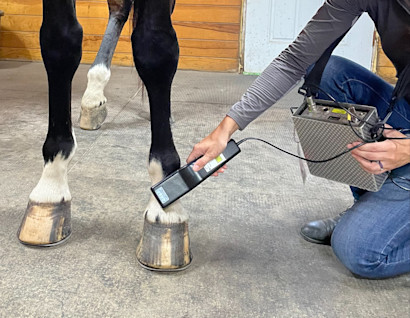Equine Therapy for Children: Psychological and Behavior Assistance Clarified
Wiki Article
Reviewing the Efficiency of Laser Therapy in Horse Treatment for Injury Rehab
The assessment of laser treatment's effectiveness in equine injury recovery rests on numerous elements, consisting of healing time, pain mitigation, and cells regeneration. Professional research studies recommend noteworthy improvements in conditions like tendonitis and osteo arthritis, attributed to enhanced mobile function and raised ATP production. Veterinarians regularly observe exceptional end results with laser therapy compared to standard methods, positioning it as a vital element in equine care. The need for continuous tracking and tailored treatment plans can not be overstated. What details clinical evidence supports these insurance claims, and how do veterinarians carry out these methods in practice?
Comprehending Laser Treatment
Laser treatment has actually come to be a crucial device in vet medication, especially in the treatment of equine conditions. Known for its non-invasive nature and effectiveness, laser treatment involves the application of details wavelengths of light to stimulate tissue fixing and minimize swelling. This restorative method is progressively preferred for its ability to increase the healing process in equines experiencing a variety of bone and joint injuries and chronic conditions.The main device behind laser therapy is its capacity to boost mobile functions. Additionally, laser treatment promotes vasodilation, boosting blood flow and oxygen distribution to damaged cells, hence speeding up recovery.
In equine medicine, laser therapy is specifically advantageous for conditions such as tendonitis, osteo arthritis, and wound recovery. The method is admired for its pain-relieving residential or commercial properties, allowing horses to reclaim movement and feature more quickly. Vets also appreciate its marginal side effects compared to various other therapy modalities, making it a trusted and safe choice for equine treatment.
How Laser Therapy Functions
To recognize how laser therapy works, it is important to look into the communication in between light power and biological tissues. Laser therapy, likewise called Low-Level Laser Treatment (LLLT) or photobiomodulation, uses specific wavelengths of light to permeate tissues and promote mobile procedures. The device rests on the absorption of photons by cell chromophores, primarily within the mitochondria, which are crucial for energy production.Upon absorption, these photons activate a collection of biochemical adjustments, enhancing mitochondrial function and leading to increased adenosine triphosphate (ATP) production. This increase in ATP speeds up mobile metabolism, promoting tissue repair and regeneration. Additionally, laser therapy regulates inflammatory responses by influencing cytokine degrees and reducing oxidative stress, thereby reducing pain and swelling.
An additional considerable aspect of laser treatment is its function in enhancing microcirculation. The treatment promotes vasodilation, improving blood circulation and oxygen shipment to damaged cells. This helps with the removal of mobile debris and sustains the spreading of fibroblasts and collagen synthesis, vital for wound recovery.
Medical Proof
The effectiveness of laser therapy in equine therapy has actually been substantiated through different professional studies, showcasing its therapeutic prospective across a variety of problems. A research carried out by Turner et al. (2012) showed that steeds treated with low-level laser treatment (LLLT) for tendon injuries showed sped up recovery contrasted to those obtaining standard therapies.In a similar way, study by Johnson and coworkers (2015) concentrated on equine muscle injuries, revealing that laser treatment substantially sped look here up muscle mass fiber regrowth and reduced muscle rigidity. These searchings for were corroborated by histological evaluations revealing better muscle tissue organization. Medical assessments have revealed that laser treatment can minimize chronic problems such as osteo arthritis. A research study by Smith et al. (2018) reported that horses with osteoarthritic joints experienced notable discomfort alleviation and enhanced variety of activity adhering to a program of laser therapy sessions.
Vet Insights
Vet professionals have increasingly acknowledged the worth of laser treatment in equine treatment, mentioning both empirical proof and direct experience. Dr. Jane you can try these out Smith, a leading equine veterinarian, notes that laser treatment has actually revealed amazing effectiveness in reducing inflammation and speeding up cells repair.Veterinarians likewise value the flexibility of laser treatment. It can be used for a wide variety of problems, from surface injuries to much deeper musculoskeletal injuries. Dr. Emily Brown highlights its utility in treating conditions like tendonitis and osteoarthritis, where traditional therapies commonly fail. She mentions that laser treatment can be customized to the details needs of each horse, ensuring optimal outcomes.

Practical Considerations
A vital element of executing laser treatment in equine treatment involves recognizing the useful factors to consider that ensure its efficacy and security. Most importantly, it is crucial to choose the appropriate laser tool, as various kinds differ in wavelength, power, and infiltration depth. Vets must be skilled in these parameters to tailor therapy protocols properly to each injury kindMoreover, the frequency and period of laser therapy sessions need mindful planning to optimize therapeutic advantages while lessening any possible unfavorable effects. Regular monitoring of the steed's feedback to treatment can guide necessary modifications in the therapy program. Establishing a risk-free and controlled environment throughout therapies is additionally important to avoid accidental exposure to laser discharges, which could harm both the steed and the handler.
Training and accreditation of personnel providing laser treatment are paramount to ensure proper strategy and to copyright safety criteria. In addition, keeping accurate records of each session, including laser settings and observed results, is crucial for reviewing the general effectiveness of the treatment and for making data-driven choices.
their website
Verdict
Laser treatment has arised as a reliable technique in equine injury rehabilitation, offering significant advantages in recovery time, discomfort alleviation, and tissue recovery. For ideal results, continuous monitoring and customized treatment protocols continue to be crucial in leveraging the complete potential of laser treatment in equine treatment.Report this wiki page